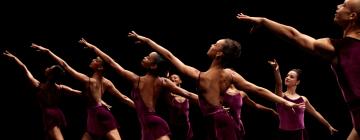Former UCSF Official Named to LA Philharmonic Position
Kathleen Kane has been appointed to the position of Vice President of Philanthropy with the Los Angeles Philharmonic, responsible for management of all the organization's fund-raising efforts, including annual fund, major gifts, grants, corporate sponsorships, planned giving, volunteer services, etc.
Kane joins the Philharmonic from City of Hope in Los Angeles, where she was most recently the Chief Philanthropy and External Relations Officer. Before moving to L.A. in 2004, Kane held several senior development positions at the University of California, San Francisco, including Associate Vice Chancellor, University Development and Alumni Relations and Vice President, UCSF Foundation, where she planned a successful $1.6 billion campus-wide campaign.
Calleja Portrays Caruso ... But Not Here
So far there are no Bay Area theaters scheduled to screen The Immigrant, a film in which tenor Joseph Calleja portrays Enrico Caruso. Directed by James Gray, and opening last weekend only in New York and Los Angeles, the film features Oscar-winner Marion Cotillard as a young Polish woman struggling to realize the American dream in a 1920s New York, as well as Jeremy Renner, and Joaquin Phoenix.
The Maltese tenor's Decca album Amore was released in the U.S. last fall, the recording inspired by great tenors of the past — Caruso, Beniamino Gigli and Tito Schipa among them.
Singer Takes On Critics
Feuding with critics is generally regarded as not a good idea, but Alice Coote is breaking new ground with her open letter on Monday to Norman Lebrecht about the issue of a singers' appearance.
Lebrecht has just collected — with disapproval — references to Tara Erraught (Octavian) at Glyndebourne as "chubby ... dumpy ... stocky," and Coote responded:
If a voice is right for a role and can sing it better than anyone else, it’s more important to have that VOICE singing on a stage than any other. Despite whether you like the way they look or not. We cannot people our operatic stages with singers that above all are believable visually or sexually attractive to our critics. That way lies the death of opera. This is not in any case a believable art form ... who are we kidding?But it is one that can move humans in ways that they cannot explain. And in ways that make them fall in love with great voices singing great music. Opera will die if audiences have only average looking, average singing humans walking around in interesting (or average) looking productions.
There has been widespread reaction to Coote's statement, not so much about the appearance issue, but because of her absolutist stand on the primacy of voice. Financial Times critic Martin Bernheimer told SFCV: "I think ideally opera is a fusion of music and drama. I don't think it is just about voices (though egocentric singers may think that)."
Sleep-Art and the Art of Sleep
Yes, really, a whole new fad of performance art is producing shows where the audience is expected to sleep.
Sort of defeats the whole purpose of going to a theater or concert hall to see and hear something. And surely, you get a better sleep at home for free than in some strange place for $100 and more.
'Donna Racik, Opera's Human Safety Net'
Corey Kilgannon writes about Met prompter Donna Rasik (a colleague of Bay Area's Jonathan Khuner) in The New York Times on Saturday:
Chances are that even devoted regulars at the Metropolitan Opera are not familiar with Donna Racik.She is an onstage presence during performances but goes unseen by the audience, and her name goes unmentioned on the cast list of performers.
She has sung in numerous operas, yet she is not an opera singer. She regularly conducts for opera singers during performances, yet she is not an orchestra conductor.
“It’s a totally hidden job, and that’s what it’s supposed to be,” Ms. Racik said.
She is a prompter, and her job is critical to the seamless performances that audiences expect from one of the world’s great opera companies.
“There are very few people who do this, so when people ask what I do, I usually tell them that I’m an extra pair of hands for the conductor,” said Ms. Racik, who during rehearsals and performances is inside a tiny booth at the edge of the stage, at shoe level with the performers.
The prompter’s box is next to the orchestra pit and opens toward the performers, concealing Ms. Racik from the audience. From her perch, she guides singers by providing them cues, mouthing or speaking words to the singers as their lines of music come up ...
